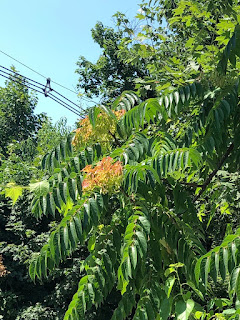What’s Happening in October
One change is some aggressive pruning in the west flower bed. You can see the scrubs that were in the background this summer. They are a lower growing type of dogwood. They seem to be identified by color with the white type forming colonies from rhizomes which would describe the summer appearance. Most of the stems here are grey or white but there are a few red and yellow. These are sometimes chosen for their winter color. The photo shows the leaf veins curving parallel to the leaf edge. The twigs are opposite as in the MAD Horse mnemonic.
There was a little discussion, these are probably the "grey" or white variety of dogwood. The red and yellow are more dramatic, bright red long twigs in the winter, not just the stems.
( The suggested identification for the three small trees just west of the south entrance is Prunus serrulata possibly the Kwanzan cultivar. It would be ornamental, not bearing fruit. Mentioned here because also suggested there is cherry shot hole disease which can be seen before all the leaves fall)
 |
| A different type of dogwood for those used to Kousa and Florida trees. |
 |
| Dogwood leaves with veins curving paralllel to margin. |
 |
| One plant with red stems. |
 |
| One group of dogwood with yellow stems |








Comments
Post a Comment